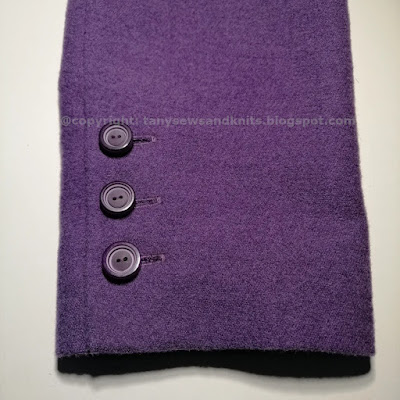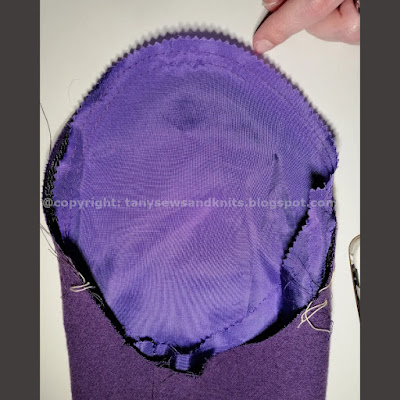EN Summary: In this article I'll share the details of the finished sleeves, before attaching them to the body of the coat. Keep reading the full article on tanysewsandknits.blogspot.com.
---
PT Sumário: Neste artigo mostro os detalhes das mangas depois de prontas para serem cosidas ao corpo do casaco. Continuem a ler o artigo completo em tanysewsnandknits.blogspot.com.
EN: As I had previously explained in this article - "Notes on sewing sleeve vents on tailored sleeves" - I prefer sewing, applying the lining and embroider the buttonholes to the vents on the flat, before closing the front seam of the two-leaf tailored sleeves both on the sleeves and the lining. This procedure allows me to sew everything by machine (except hand-tacking the sleeve hems in place, which should always be done) and delivers a very professional finish on the sleeve cuff and vent.
---
PT: Como já tinha explicado neste artigo - "Como coser as aberturas nas mangas de alfaiate" - prefiro confecionar as aberturas, aplicar-lhes o forro e bordar as casa de botão com as mangas ainda sem fechar a costura da frente (as mangas de duas peças têm uma costura na frente e outra atrás, onde fica posicionada a abertura). Este procedimento permite-me coser tudo à máquina, exceto prender a bainha da manga no lugar (feito com pontos cruzados à mão), e proporciona um acabamento muito profissional no punho da manga e na sua abertura.
EN: If the lining pattern pieces of the lining are cut accurately, everything falls into place and a 3/8" ease pleat is added to the lining hem. The visible topstitching on the top of the vent can be omitted and done only on the wrong side, joining the top edge of the lining vent to the top edge of the sleeve vent facings.
---
PT: Se o molde das mangas em forro tiver sido desenhado e cortado com precisão, tudo fica no seu lugar e forma-se uma prega horizontal de 1cm de profundidade na bainha do forro. O pesponto no topo da abertura pode ser feito apenas por dentro, prendendo a beira superior da abertura em forro apenas às vistas da abertura da manga
EN: The sleeve caps on both the sleeve and sleeve lining should be edged with a double row of long lose stitches, so the sleeve can be attached and eased to the armhole. There are two possible methods to attach the sleeves and the sleeve's lining (in both, the body of the coat should already be lined):
1 - The couture method: first the sleeve (fashion fabric) is sewn to the coat's armhole by machine, then the shoulder pads are tacked in place and the lining armhole is hand-basted on top of the armhole seam and pads; then the sleeve lining is sewn by hand on top of the previous seam on the inside, using a double strand of color-matched thread which should have been previously waxed for strength and durability. With this method, the sleeve lining is completely secured and won't shift out of place. I demonstrated this method in the Great coat Sew-along series (here), just scroll down for the English version.
2 - The modern industrial method: the fabric sleeve is sewn by machine to the armhole of the coat first, and afterwards, reaching inside between coat and lining, the lining sleeve should be attached to the lining armhole. The lining should be tacked to the coat on the top and bottom of the armholes using thread bridges or small pieces of lining selvedge. This method will also prevent the lining sleeve from shifting out of place.
---
PT: As cabeças da manga em ambos manga e forro devem levar pontos longos e soltos para embeber a manga na cava depois. Há dois métodos possíveis de coser as mangas preparadas já com o forro metido (em ambos o restante forro do casaco já deverá ter sido cosido às vistas do casaco):
1 - Método alta-costura: Cose-se as mangas do casaco em tecido à cava do casaco, aplica-se os chumaços no ombro e alinhava-se a cava do forro sobre a costura da cava e o chumaço; depois cose-se à mão a manga em forro por cima e por dentro, cobrindo a costura. Deve-se usar linha dupla na agulha, previamente fortalecida com cera de abelha. Com este método a manga em forro fica completamente fixa na cava, sem correr riscos de repuxar ou torcer. Demonstrei este método no "Great Coat Sew-along", podem consultá-lo
aqui.
2 - Método moderno industrial: a manga em tecido é cosida à máquina à cava em tecido do casaco e depois, metendo as mãos entre o casaco e o forro, a manga em forro é cosida à cava em forro também à máquina. Para evitar que a manga em forro se desloque e repuxe, o forro deve ser fixado ao casaco pelo avesso, no topo e na base da cava, usando uma corrente de linha ou pedaços de aurela de forro cosidos a ambos. Este processo evita que a manga em forro torça ou repuxe mas não a fixa completamente em torno da cava, só em cima e em baixo.
EN: I've also reinforced the sleeve cap with fusible interfacing; I find that this simple step helps easing the sleeve in without unwanted puckers.
---
PT: Também costumo reforçar a cabeça da manga com entretela termo-colante; este passo, na minha opinião, ajuda a embeber a cabeça da manga na cava sem aquelas engelhas inestéticas.
EN: I will use the modern industrial method on this coat and I will also attach sleeve-heads and insert tailoring shoulder pads before attaching the sleeve lining to the lining armhole.
Thank you all for visiting!
---
PT: Vou usar o método industrial moderno neste casaco e também aplicarei cabeças de manga e chumaços, antes de coser a manga em forro à cava em forro.
Obrigada a todos por aparecerem!











No comments:
Post a Comment